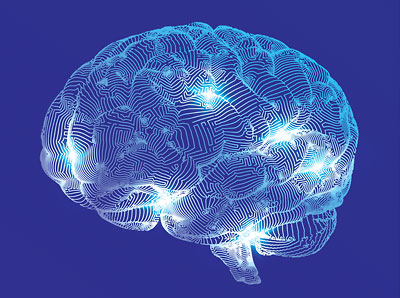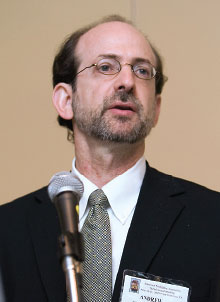Precision Brain Stimulation Moves Closer to Reality
Abstract
Researchers are tailoring transcranial magnetic stimulation and deep brain stimulation to target individual patients’ symptoms and neural activity, with impressive results.

For more than four decades, Memphis resident Tommy Van Brocklin, 61, has faced an uphill battle against depression. Since being diagnosed with depression at age 15, Van Brocklin has at times experienced brief relief from his symptoms with medication, but just as regularly, his symptoms have returned.
Van Brocklin’s experience is not rare: He is one of an estimated 2.8 million Americans living with treatment-resistant depression, hoping for some medical breakthrough.
Last September, following a suggestion from his sister who lives in California, Van Brocklin went to Stanford University to undergo an experimental form of magnetic brain stimulation known as the Stanford Neuromodulation Therapy (SNT). SNT condenses six weeks of treatments into just five days.
“During the first day I was getting used to the intensity of the procedure,” he told Psychiatric News. “Then on the second day I became emotional, and a little scared, as I thought back to everything I had been through over the years.”
But on the third day, something clicked, Van Brocklin recalled. “I felt this profound relief. It’s like I finally knew what was B.S. and what was reality.”
Location Matters
Brain stimulation therapies, such as SNT, are not new in depression care. Magnetic stimulation was approved for treatment-resistant depression in 2008, and doctors have been using electroconvulsive therapy to treat depression for more than 75 years. Until recently, however, neuromodulation has been an imprecise therapy.
“We have a rough idea where the brain circuits involved in depression are located, but we have to recognize that every individual has a unique wiring diagram,” said Michael Fox, M.D., director of the Center for Brain Circuit Therapeutics at Brigham and Women’s Hospital in Boston. That’s why neuromodulation strategies that target a specific region won’t work for every patient, Fox said. The SNT protocol takes a big step toward personalized treatment, he continued.
Prior research had suggested that poor neural connections between the prefrontal cortex (the brain region involved in decision-making) and subgenual cingulate (a region in the inner brain that regulates emotions) may contribute to depression. Before initiating SNT treatment, patients receive two MRI scans to identify the portion of the prefrontal cortex that exhibits the least amount of connectivity with the subgenual cingulate, and that site becomes the TMS target. The strength of the magnetic stimulation for each patient is then adjusted—based on the depth of the target site—so that patients receive 90% of their motor threshold (the magnetic power needed to make a person’s thumb twitch).
The effectiveness of SNT was recently validated in a randomized, controlled trial. For this study, the results of which were published in the American Journal of Psychiatry in February, 29 adults with treatment-resistant depression received five days of either SNT or sham magnetic stimulation ("New Stanford Protocol for TMS Found to Achieve Fast Remission"). The participants received weekly assessments for a month following treatment.
After five days of treatment, depression scores (assessed with the Montgomery-Åsberg Depression Rating Scale, or MADRS) dropped by 62.0% among participants in the SNT group compared with 14.3% in the sham group; these results were sustained over the four-week follow-up. Additionally, 78.6% of participants in the SNT group achieved clinical remission (defined as a MADRS score of ≤10) at some point in the study, compared with just 13.3% of the participants in the sham group.
“These effects are huge,” said SNT developer Nolan Williams, M.D., director of the Stanford Brain Stimulation Laboratory. “You [typically] do not see differences this large between an intervention and placebo in psychiatry trials.”
Tailoring Therapy to Symptoms
Magnet-based stimulation is not the only form of neuromodulation for which personalization can make a big difference. Researchers have recently made significant progress in making deep brain stimulation (DBS)—which involves the periodic discharge of electricity from tiny electrodes that are implanted in the inner brain—more precise. DBS is approved to treat severe tremors associated with Parkinson’s disease or epilepsy, and it was hoped by some doctors that it might be an option for people with severe, chronic depression who did not respond to any other therapies.
Unfortunately, clinical trials testing DBS for depression to date have produced disappointing results, leaving DBS in therapeutic limbo. Additionally, researchers remain unclear on where to place the electrodes for the biggest effect in people with depression ("Experts Debate What's Next for DBS for Depression").
About 30 miles up the road from the laboratory where the SNT protocol was developed, a research team at the University of California, San Francisco (UCSF), has developed a DBS strategy known as closed-loop neuromodulation. The approach, which was tested in a female volunteer with depression, involves implanting 10 tiny sensors into brain regions associated with depression. Each sensor has an electrical stimulator that can activate nearby neurons as well as an electroencephalography (EEG) recorder to measure brainwave activity.

“In the future we might be able to use neuroimaging instead of implants to predict the ideal place and time for stimulation.” —Andrew Krystal, M.D.
For 10 days, the researchers stimulated each of the 10 individual sensors at varying frequencies while asking the volunteer how she felt before and after the stimulation. As senior investigator Andrew Krystal, M.D., the Dagmar Dolby Distinguished Professor and Vice Chair for Research in Psychiatry at UCSF explained, the sensor affirmed the complexity of depression.
“For example, when we stimulated the ventral striatum, the patient felt more alert and attentive, but stimulating the orbitofrontal cortex led to a calming effect,” he said. “If the patient was already aroused when we stimulated the ventral striatum, it became a case of overstimulation, and the patient became anxious. That told us we need to not only find the best place to stimulate, but also when to stimulate.”
Krystal said that the busy 10-day evaluation stage was enlightening. “In my clinical work with patients, I have always felt I have been looking in from outside of a window and now I could finally open it,” he said.
Based on the data from those 10 days and the patient’s own reporting that anhedonia (lack of pleasure) was her most severe symptom, the UCSF team implanted a DBS electrode in the ventral striatum that sent out a six-second stimulation when it detected a neural biomarker that indicated low arousal. “We observed that on average the electrode was only active for 20 to 30 minutes each day, which has practical implications,” Krystal said. Among these are preserving the battery life of the electrodes to minimize replacement surgeries; reducing side effects; and preventing the brain from adapting to the stimulation, which would weaken the effect.
“We also are thinking about how we can refine this procedure to make it even safer,” Krystal added. “In the future we might be able to use neuroimaging instead of implants to predict the ideal place and time for stimulation, which would remove one surgical procedure.”
Fox said Krystal’s study could be a pivotal moment in DBS. “The UCSF study is a great example of tailoring a therapy based on a person’s symptoms, not disorder,” he said. “After tremendous initial hype, the prospect of DBS for depression entered the trough of disillusionment when the large clinical trials failed ... Now we may have finally found a ramp to get us out toward a period of gradual progress.”
Patients Attest to Effectiveness
Though the scientific data from both research projects has been promising, the patient testimonials may really showcase how powerful brain stimulation can be when the parameters are optimized.
“In the early few months, the lessening of the depression was so abrupt, and I wasn’t sure if it would last,” said Sarah, the participant of the UCSF trial, in a university press release. “But it has lasted.” The brain stimulation coupled with other therapy has been particularly effective at managing irrational thoughts on which she used to obsess. “Now,” she said, “those thoughts still come up, but it’s just ... poof. The cycle stops.”
Van Brocklin has also been going strong. “I was worried that my change would come and go after a couple of weeks, but instead I feel like I keep getting better every day,” he said.
The SNT clinical trial was supported by the Brain and Behavior Research Foundation (BBRF), Charles R. Schwab, the David and Amanda Chao Fund II, the Amy Roth PhD Fund, the Neuromodulation Research Fund, the Lehman Family, the Still Charitable Trust, the Marshall and Dee Ann Payne Fund, and the Gordie Brookstone Fund. The DBS pilot study was supported by BBRF, a grant from the National Institute of Neurological Disorders and Stroke, and the Ray and Dagmar Dolby Family Fund. ■



